Extensive research has been carried out in recent years on finishing systems for hill and crossbred lambs of varying weights.
The research has focused primarily on indoor finishing with some trials combining a short period of grazing.
At the same time as these trials have taken place, there has been growing interest in the role of forage crops in finishing lambs.
This has been underpinned in recent years by regulations surrounding green cover crops on tillage lands and measures in the Green Low-carbon Agri-Environment Scheme (GLAS).
These crops readily lend themselves to being grazed by sheep with the greatest potential likely to be in finishing store lambs.
As such, a trial assessing the potential role of finishing store lambs commenced in Teagasc, Mellows Campus Athenry, in 2019.
The five-year study has two main objectives – to examine the performance of hill and crossbred hill lambs when grazed on a selection of forages and to quantify the differences in crop yield potential and carrying capacity of these forages when utilised in store lamb finishing systems.
The trial is being headed up by researcher Frank Campion and managed day-to-day by PhD research student, Mark Dolan.
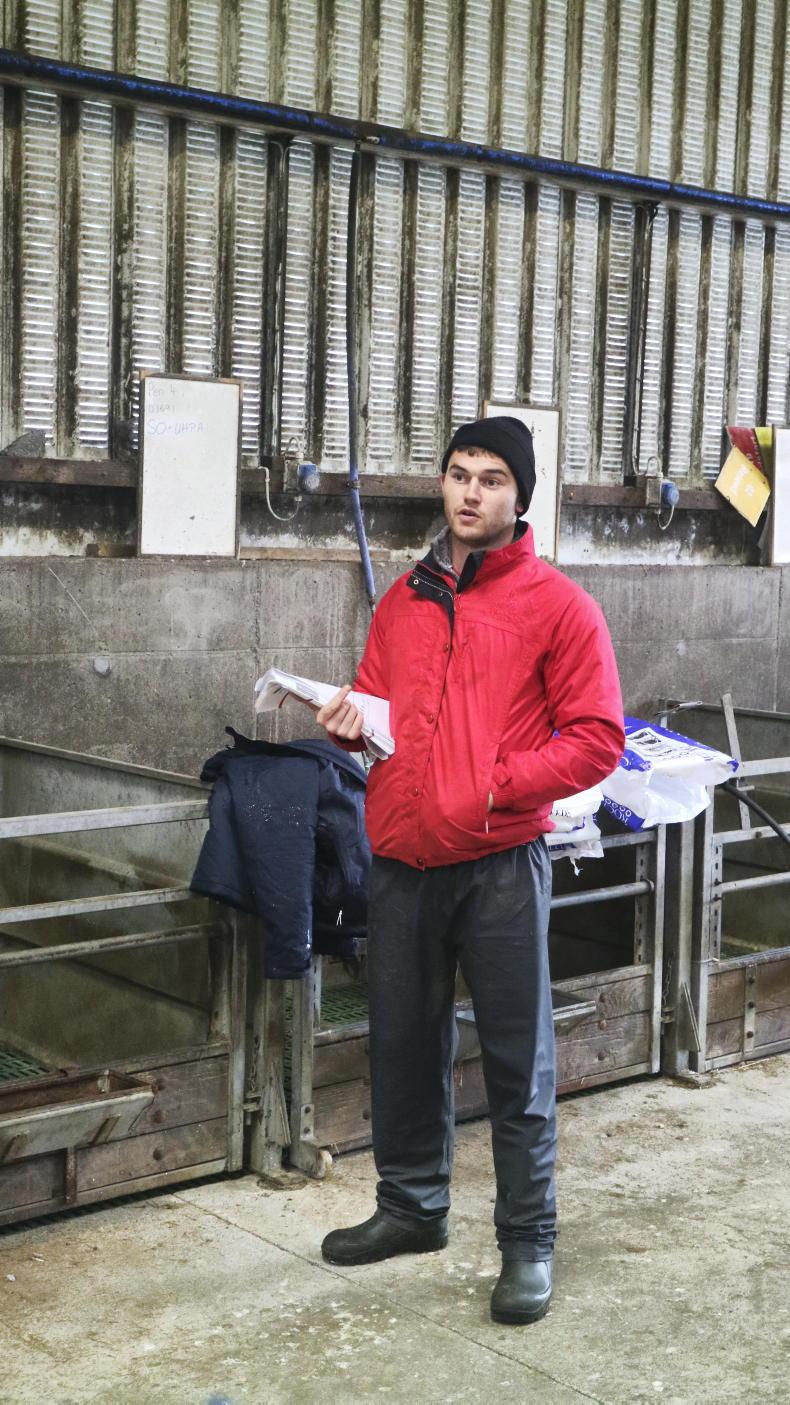
Mark Dolan, PhD researcher working on the forage crops trial.
One of the challenges facing the trial is where it is located with these crops typically sown in the east and south where rainfall levels are significantly lower than in Athenry.
Crop utilisation and lamb performance has been hampered somewhat in 2019 and 2020, so it is welcoming to see that largely favourable grazing conditions in 2021 will provide a better assessment of potential performance.
Six treatments
There are six treatments under scrutiny including three forage crops – kale (Maris Kestral variety) forage rape (Stego variety) and a hybrid brassica (Redstart).
The more conventional finishing systems are being put to the test through permanent pasture swards comprising predominantly perennial ryegrass along with a perennial ryegrass reseed (Abergain and Aberchoice varieties).
The indoor finishing treatment is an ad-lib concentrate diet with a small volume of silage offered for rumen function.
Production records
Mark explains that the aim in terms of lamb performance is to draft as high a percentage of lambs as possible for slaughter direct off the grazing treatments.
This allows slaughter performance factors such as kill-out, carcase conformation, fat score, etc, to be captured, thereby strengthening the analysis.
Some work will also be completed on meat quality characteristics and rumen function along with other production aspects such as the incidence of lameness, worm burdens and fleece soiling scores.
Crop performance
The yield of kale was unusually low in 2020, at 5.5t/ha, with the crop performing much better in 2021 and producing in the region of 8t dry matter (DM) per hectare (ha).
The yield of the hybrid brassica crop was also marginally lower than expected in 2020, with early estimates pointing to the yield of both the hybrid brassica and forage rape likely to be in the region of 6t DM/ha to 7t DM/ha in 2021.
Regarding the level of utilisation, both forage rape and the hybrid brassica achieved significantly higher levels of utilisation than kale in 2020
There has been a challenge in achieving desired utilisation in 2021 as some of the crop had lodged due to high growth.
Mark explains that the majority of the lodged crop has now been grazed and that yield and utilisation should improve from here on.
Regarding the level of utilisation, both forage rape and the hybrid brassica achieved significantly higher levels of utilisation than kale in 2020.
This is because kale has a thicker stem and lambs have difficulty in grazing it down to a low level.
Fantastic growth
This is a similar feature of the crop in 2021 and Mark explains: “The growth of the rape crop has been excellent and nearly too good in 2021 with the crop reaching heights of four to five feet in places.
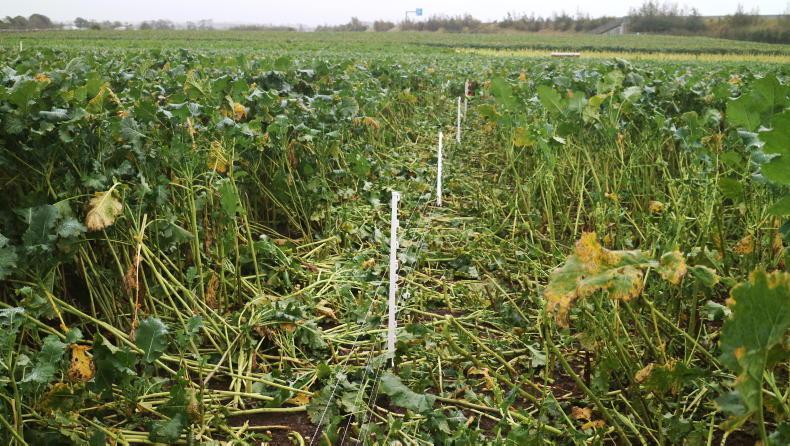
The two-day allocations are provided via breaks in the crops being strimmed and temporary electric wires being erected.
“The lambs do not seem to have any problem grazing the leaf portion of the crop and have become accustomed to reaching up or leaning on the stems to access it.
“They are eating a good percentage of the top of the stem but are slower to eat it as it gets thicker towards the bottom.
“If we left the lambs without a move [to fresh crop] for longer, they would eat more of the stem, but we are trying to find the best balance between optimising utilisation and not hitting lamb performance.”
It is still early days in the trial but it looks like the other two forage crops may have the edge on kale in terms of suitability for finishing lambs.
Lambs are still receiving two-day allocations while, in 2020, daily allocations were introduced in early November
Utilisation to date in 2021 is also running in the region of 50% to 60% with utilisation of the leaf component of the crop excellent and estimated to be in the region of 90%. This is being driven by relatively dry underfoot conditions.
“Lambs are still receiving two-day allocations while, in 2020, daily allocations were introduced in early November to try and improve utilisation which started out at 60% to 70% but fell during periods of heavy rainfall to as low as 40%.
Lamb performance
Lamb performance is assessed on daily liveweight gain and slaughter performance. Lamb performance varies significantly on the forage crops depending on how long lambs have been grazing on the crop and utilisation and dry matter.
Daily liveweight gains will be poor at the outset, ranging from 40g to 70g per head daily over the first couple of weeks. Frank explains this is due to lambs transitioning to the new crop and a major adjustment in gut fill.
Once accustomed to the crop, performance in the region of150g to 250g is common during periods of low rainfall with overall performance detailed in Figure 1.
The 2021 trial lambs were weighed last week. Lambs grazing on the three forages crops of kale, forage rape and hybrid brassica are gaining 140g/day, 160g/day and 133g/day on average since the adaptation period.
Lambs on the reseed gained 50g/day while the permanent pasture treatment ran out of treatment feed two weeks ago.
There has been a small percentage of lambs drafted from the five forages to date.
Table 1 details slaughter performance for lambs drafted direct from the crops in 2020.
The number of lambs drafted was highest in the forage rape treatment at 62%, while the hybrid brassica treatment was next up at 53% and closely followed by kale at 34%.
There was about 22% of lambs drafted in the reseeded sward treatment and at 4% in the permanent pasture treatment.
Frank explains that the weight at which lambs are transferred on to the crop has a major bearing on drafting weights and lighter lambs will require a lot of forage to bring to slaughter weights.
Daily management
Lambs grazing across the treatments are a mixture of Scottish Blackface and crossbred wether and ram lambs (mainly Texel x Scottish Blackface).
As mentioned already, lambs are offered access to crops on two-day allocations to optimise utilisation.
Frank explains that, irrespective of how lambs perform, there will be lighter lambs which are unlikely to be finished and drafted direct off the crop
Lambs are being offered straw as a roughage source and are consuming small volumes averaging in the region of 60g to 70g daily.
Frank explains that, irrespective of how lambs perform, there will be lighter lambs which are unlikely to be finished and drafted direct off the crop.
He sees this as an opportunity to also develop blueprints for using forage crops to bring light lambs to heavier weights before transferring indoors for intensive finishing.
In recent years, concentrates have been introduced in advance of the entire crop being grazed to facilitate a smooth transition to an indoor environment.
Potential for forage crops
The economics of sowing forage crops stack up financially when incorporated at a lower cost into stubble ground.
However, the economics of replacing a grassland sward with a forage crop are questionable, particularly in light of the performance achieved on reseeded swards.
The exception to this statement is incorporating forage crops as part of a land reclamation project or possibly in parts of the country where forage crops are sown to provide a high volume of feed to finish lambs in a self-contained system with the crops grazed a number of times during the season.
The information stemming from this trial will be highly beneficial in the future for developing blueprints to best utilise forage crops which are likely to remain a mainstay in policy regulations and agri-environmental schemes.
Extensive research has been carried out in recent years on finishing systems for hill and crossbred lambs of varying weights.
The research has focused primarily on indoor finishing with some trials combining a short period of grazing.
At the same time as these trials have taken place, there has been growing interest in the role of forage crops in finishing lambs.
This has been underpinned in recent years by regulations surrounding green cover crops on tillage lands and measures in the Green Low-carbon Agri-Environment Scheme (GLAS).
These crops readily lend themselves to being grazed by sheep with the greatest potential likely to be in finishing store lambs.
As such, a trial assessing the potential role of finishing store lambs commenced in Teagasc, Mellows Campus Athenry, in 2019.
The five-year study has two main objectives – to examine the performance of hill and crossbred hill lambs when grazed on a selection of forages and to quantify the differences in crop yield potential and carrying capacity of these forages when utilised in store lamb finishing systems.
The trial is being headed up by researcher Frank Campion and managed day-to-day by PhD research student, Mark Dolan.

Mark Dolan, PhD researcher working on the forage crops trial.
One of the challenges facing the trial is where it is located with these crops typically sown in the east and south where rainfall levels are significantly lower than in Athenry.
Crop utilisation and lamb performance has been hampered somewhat in 2019 and 2020, so it is welcoming to see that largely favourable grazing conditions in 2021 will provide a better assessment of potential performance.
Six treatments
There are six treatments under scrutiny including three forage crops – kale (Maris Kestral variety) forage rape (Stego variety) and a hybrid brassica (Redstart).
The more conventional finishing systems are being put to the test through permanent pasture swards comprising predominantly perennial ryegrass along with a perennial ryegrass reseed (Abergain and Aberchoice varieties).
The indoor finishing treatment is an ad-lib concentrate diet with a small volume of silage offered for rumen function.
Production records
Mark explains that the aim in terms of lamb performance is to draft as high a percentage of lambs as possible for slaughter direct off the grazing treatments.
This allows slaughter performance factors such as kill-out, carcase conformation, fat score, etc, to be captured, thereby strengthening the analysis.
Some work will also be completed on meat quality characteristics and rumen function along with other production aspects such as the incidence of lameness, worm burdens and fleece soiling scores.
Crop performance
The yield of kale was unusually low in 2020, at 5.5t/ha, with the crop performing much better in 2021 and producing in the region of 8t dry matter (DM) per hectare (ha).
The yield of the hybrid brassica crop was also marginally lower than expected in 2020, with early estimates pointing to the yield of both the hybrid brassica and forage rape likely to be in the region of 6t DM/ha to 7t DM/ha in 2021.
Regarding the level of utilisation, both forage rape and the hybrid brassica achieved significantly higher levels of utilisation than kale in 2020
There has been a challenge in achieving desired utilisation in 2021 as some of the crop had lodged due to high growth.
Mark explains that the majority of the lodged crop has now been grazed and that yield and utilisation should improve from here on.
Regarding the level of utilisation, both forage rape and the hybrid brassica achieved significantly higher levels of utilisation than kale in 2020.
This is because kale has a thicker stem and lambs have difficulty in grazing it down to a low level.
Fantastic growth
This is a similar feature of the crop in 2021 and Mark explains: “The growth of the rape crop has been excellent and nearly too good in 2021 with the crop reaching heights of four to five feet in places.

The two-day allocations are provided via breaks in the crops being strimmed and temporary electric wires being erected.
“The lambs do not seem to have any problem grazing the leaf portion of the crop and have become accustomed to reaching up or leaning on the stems to access it.
“They are eating a good percentage of the top of the stem but are slower to eat it as it gets thicker towards the bottom.
“If we left the lambs without a move [to fresh crop] for longer, they would eat more of the stem, but we are trying to find the best balance between optimising utilisation and not hitting lamb performance.”
It is still early days in the trial but it looks like the other two forage crops may have the edge on kale in terms of suitability for finishing lambs.
Lambs are still receiving two-day allocations while, in 2020, daily allocations were introduced in early November
Utilisation to date in 2021 is also running in the region of 50% to 60% with utilisation of the leaf component of the crop excellent and estimated to be in the region of 90%. This is being driven by relatively dry underfoot conditions.
“Lambs are still receiving two-day allocations while, in 2020, daily allocations were introduced in early November to try and improve utilisation which started out at 60% to 70% but fell during periods of heavy rainfall to as low as 40%.
Lamb performance
Lamb performance is assessed on daily liveweight gain and slaughter performance. Lamb performance varies significantly on the forage crops depending on how long lambs have been grazing on the crop and utilisation and dry matter.
Daily liveweight gains will be poor at the outset, ranging from 40g to 70g per head daily over the first couple of weeks. Frank explains this is due to lambs transitioning to the new crop and a major adjustment in gut fill.
Once accustomed to the crop, performance in the region of150g to 250g is common during periods of low rainfall with overall performance detailed in Figure 1.
The 2021 trial lambs were weighed last week. Lambs grazing on the three forages crops of kale, forage rape and hybrid brassica are gaining 140g/day, 160g/day and 133g/day on average since the adaptation period.
Lambs on the reseed gained 50g/day while the permanent pasture treatment ran out of treatment feed two weeks ago.
There has been a small percentage of lambs drafted from the five forages to date.
Table 1 details slaughter performance for lambs drafted direct from the crops in 2020.
The number of lambs drafted was highest in the forage rape treatment at 62%, while the hybrid brassica treatment was next up at 53% and closely followed by kale at 34%.
There was about 22% of lambs drafted in the reseeded sward treatment and at 4% in the permanent pasture treatment.
Frank explains that the weight at which lambs are transferred on to the crop has a major bearing on drafting weights and lighter lambs will require a lot of forage to bring to slaughter weights.
Daily management
Lambs grazing across the treatments are a mixture of Scottish Blackface and crossbred wether and ram lambs (mainly Texel x Scottish Blackface).
As mentioned already, lambs are offered access to crops on two-day allocations to optimise utilisation.
Frank explains that, irrespective of how lambs perform, there will be lighter lambs which are unlikely to be finished and drafted direct off the crop
Lambs are being offered straw as a roughage source and are consuming small volumes averaging in the region of 60g to 70g daily.
Frank explains that, irrespective of how lambs perform, there will be lighter lambs which are unlikely to be finished and drafted direct off the crop.
He sees this as an opportunity to also develop blueprints for using forage crops to bring light lambs to heavier weights before transferring indoors for intensive finishing.
In recent years, concentrates have been introduced in advance of the entire crop being grazed to facilitate a smooth transition to an indoor environment.
Potential for forage crops
The economics of sowing forage crops stack up financially when incorporated at a lower cost into stubble ground.
However, the economics of replacing a grassland sward with a forage crop are questionable, particularly in light of the performance achieved on reseeded swards.
The exception to this statement is incorporating forage crops as part of a land reclamation project or possibly in parts of the country where forage crops are sown to provide a high volume of feed to finish lambs in a self-contained system with the crops grazed a number of times during the season.
The information stemming from this trial will be highly beneficial in the future for developing blueprints to best utilise forage crops which are likely to remain a mainstay in policy regulations and agri-environmental schemes.








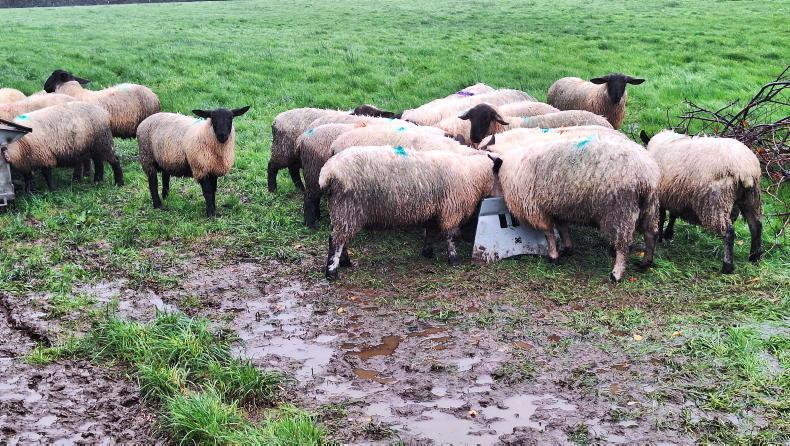

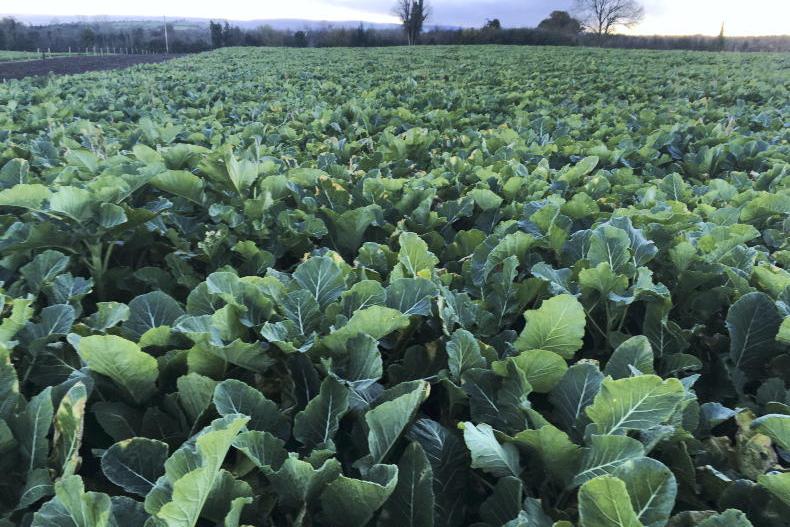
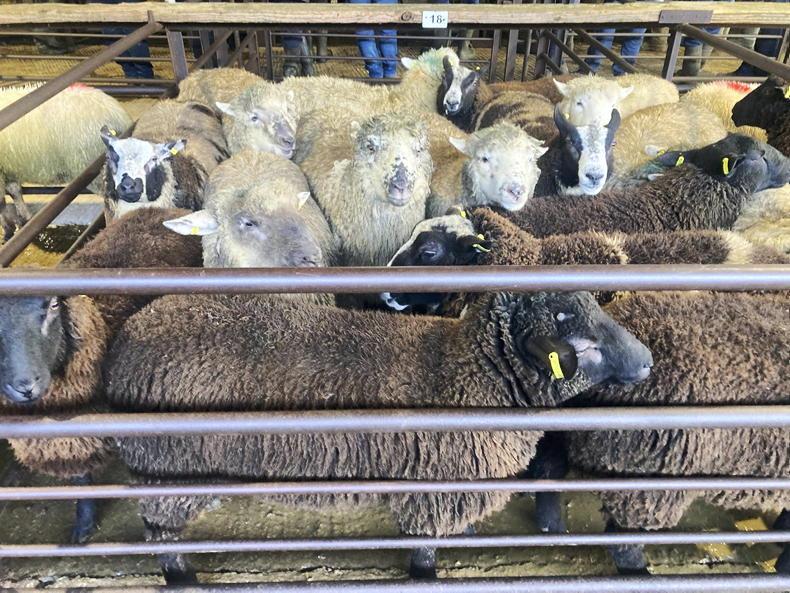
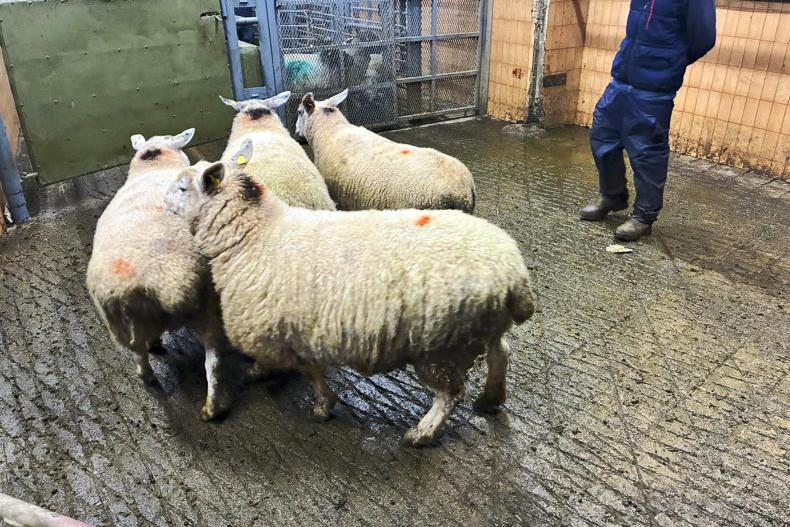
SHARING OPTIONS